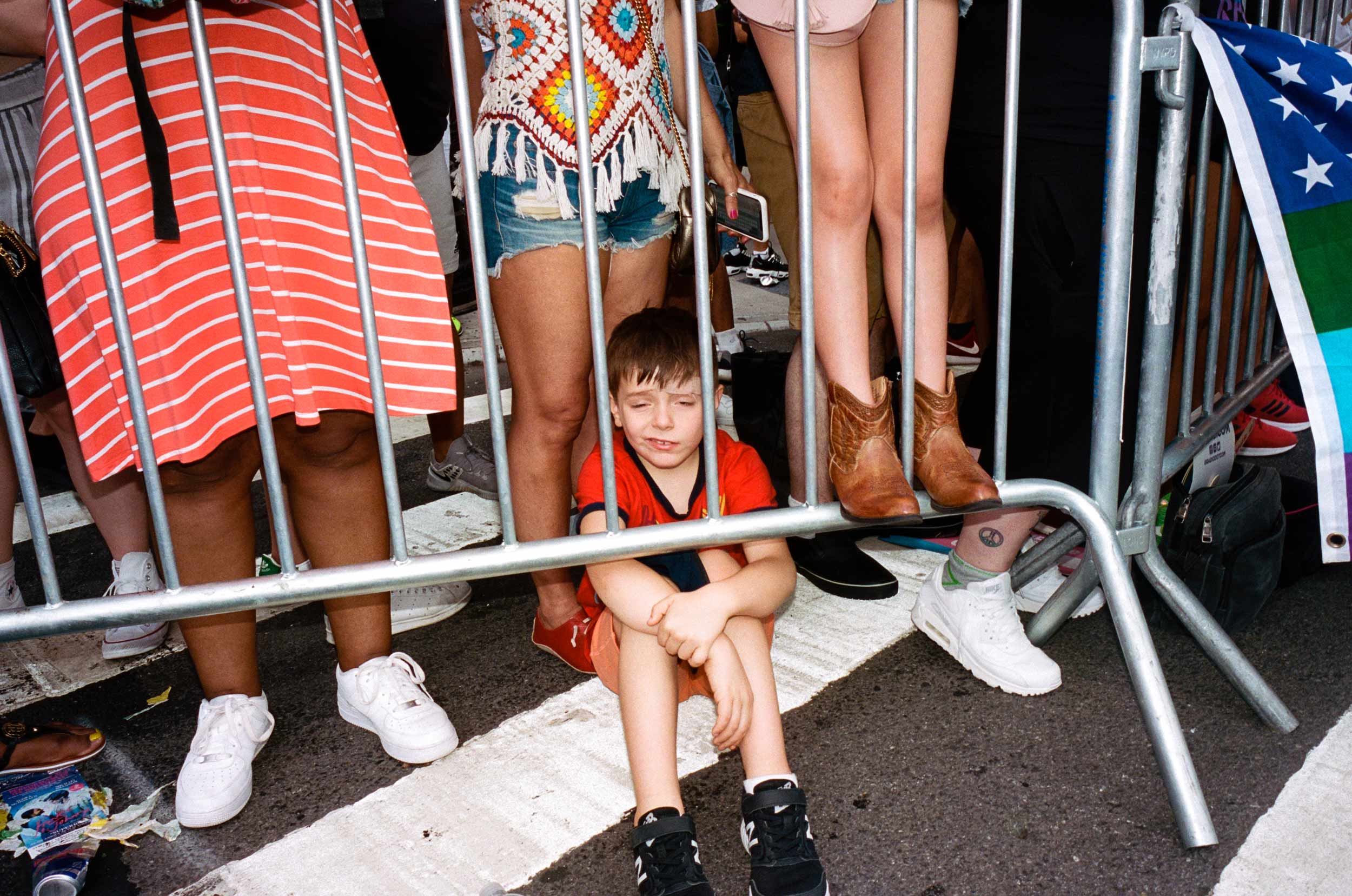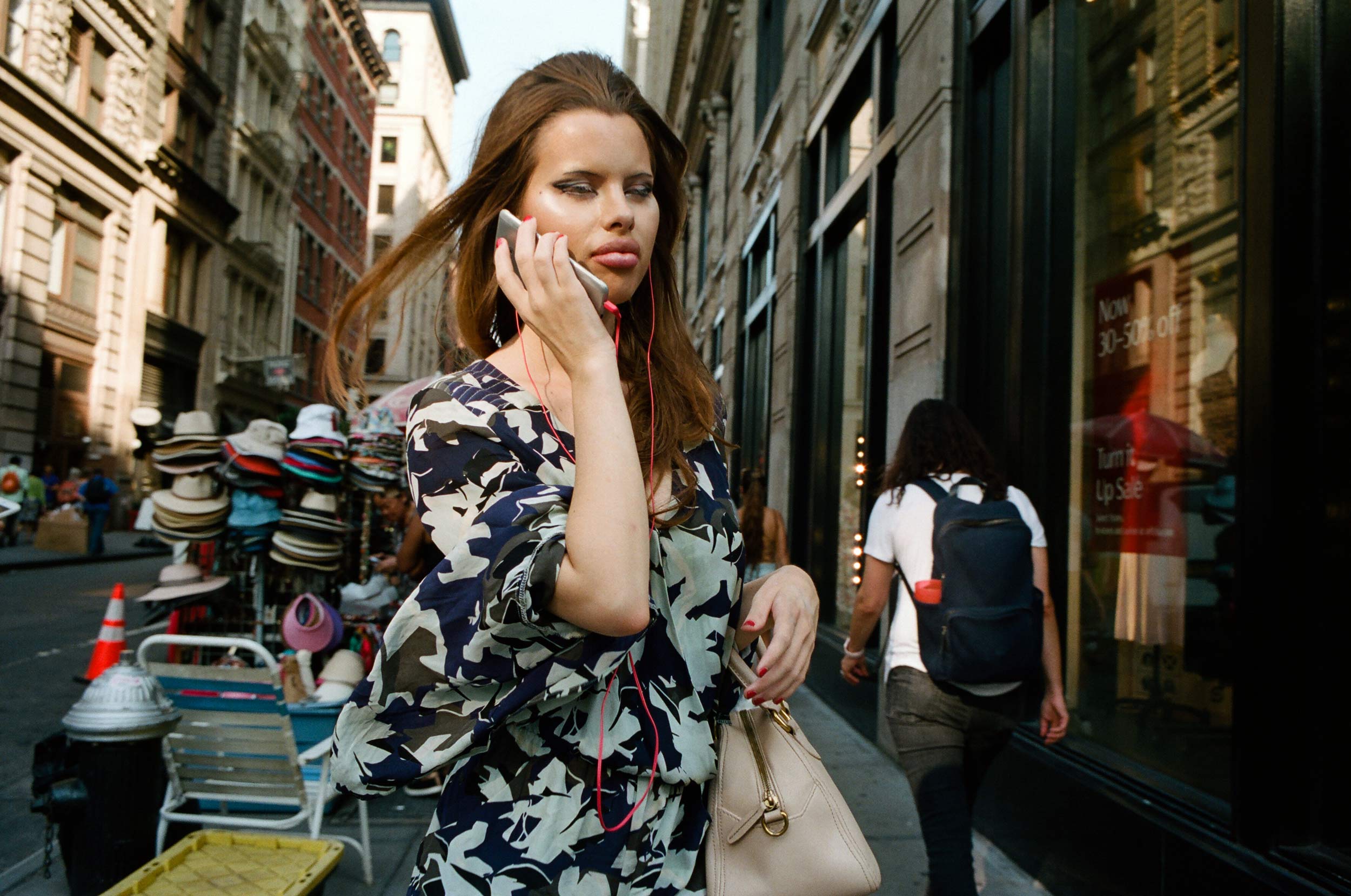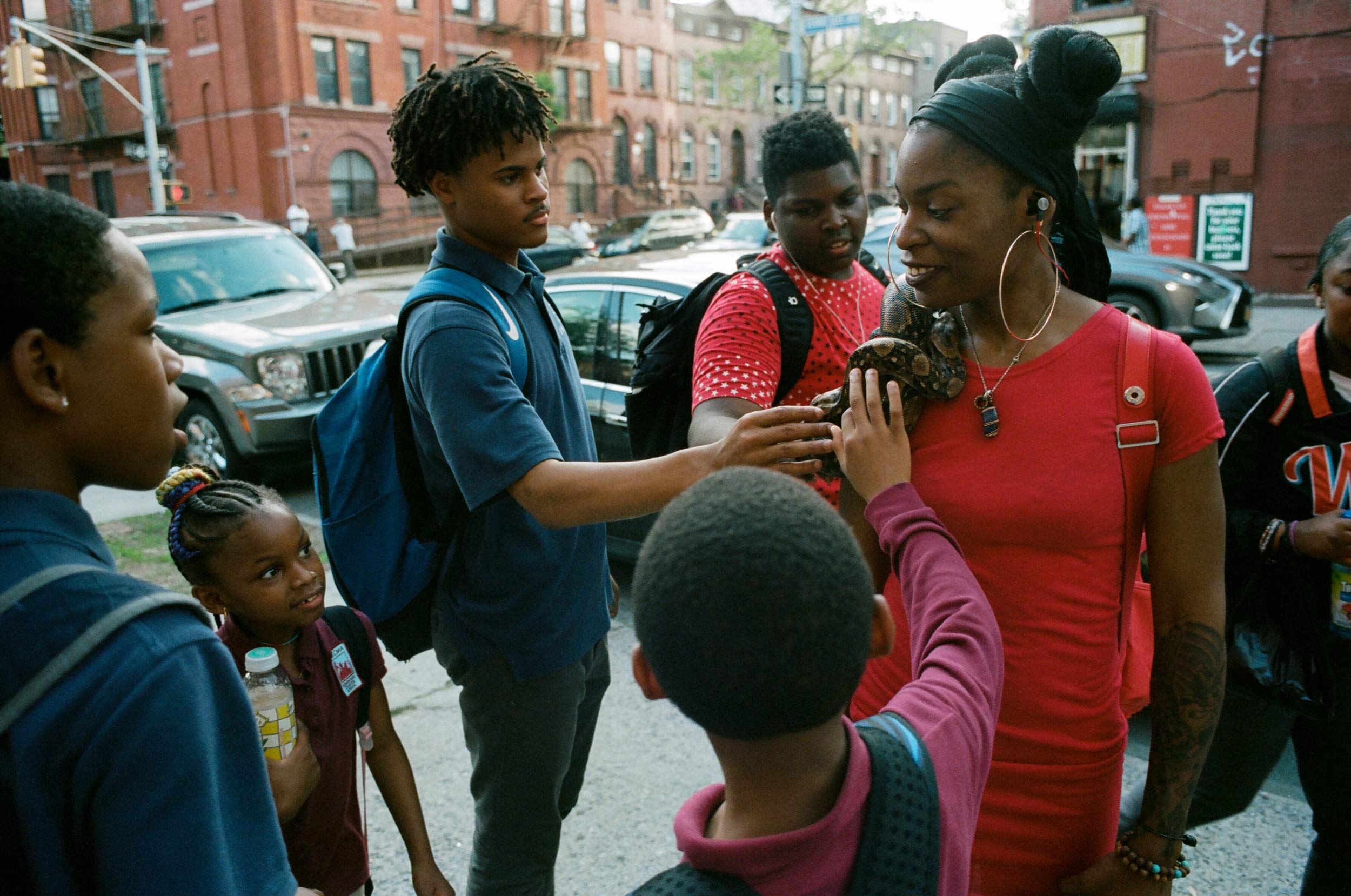The writer-turned-photographer on his first solo show and why he sees the streets of New York as a perpetually exciting sandwich platter
Calling Daniel Arnold ‘incredibly prolific’ might be an understatement. Well-known for his street photography—regularly viewed by his over 244,000 followers on Instagram—and for work for institutions like The New Yorker and Vogue, he will often snap thousands of photos in a single day. It seems remarkable that Arnold is only now showcasing his work with his first solo exhibition, at the Lower East Side gallery Larrie. Curated by former Vogue photo editor, Emily Rosser, 1:2:1 is a previously unseen collection of photographs and videos taken in the streets of New York this past summer.
Arnold, originally from Wisconsin, first came to New York to assist his cousin who was running for judge in the Lower East Side on her campaign. “She needed someone to take her abuse all day and still love her at the end,” the photographer recently explained to Document at Picture House, where he was printing the show’s images. “It’s also 2003 and iPhones don’t exist. It’s unfathomable now, to show up someplace and not have GPS. You have to be at the mercy of some very short-fused tyrant, who needs you to be all over the city at all times of the day, all at once. And I don’t know where the hell anything is. It was a very different New York life; it’s like unthinkable now. But it was a great introduction.”
This experience was followed by a series of writing gigs; first as a music and film reviewer at smaller magazines and blogs, then later as a staff writer at larger companies like Vice Media, MTV and Nickelodeon. But in his spare time, his interest in photography was beginning to form. “For the sake of occupying my busy mind, I’d go to two shows every night,” he says. “I’d set up shop in the front row with my little camera and try to figure out how to use it. The next day I’d have the pictures to send to the bands. I stumbled into all of this unexpected currency where I’d go and have fun. I’d hide behind my camera so I didn’t feel weird in the room. I had a reason to connect with everyone involved.”
Since those early days, a combination of great luck and an obsession with shooting led Arnold to a series of big breaks—one of which was catalyzed by the creation of Instagram. (“Right off the bat, my photos catch. I had pretty good momentum right from the beginning,” he recalls.) Another was an opportunity to shoot the Met Gala in 2015. “Vogue liked me enough to put me there. And I don’t say this often, but I feel like that first Met Gala was a big tide changer for me.” He’s been an in-demand fixture in the industry since, toggling between commissioned work and his street photography—and now, for the first time, adding gallery shows to the list. Document spoke with Arnold about his inner struggle with labeling himself an ‘artist’ and agreeing to present his inaugural solo.
Paige Silveria—Early on you were predominantly focused on writing. What did the beginning of the shift towards shooting look like?
Daniel Arnold—Since moving to the city, my gut intuition was that I always had to have a camera. Any time I didn’t, there would be, like, 50 things on every block that I wanted to take with me. And I had this slimly populated but very busy life. You could ask me what I did yesterday and I’d have no idea. So taking photos was also just to keep track. Little by little, I managed to make some friends and I’d take pictures of them. And if you’re the photographer in the group, you’re sort of responsible for the mythology of your time together. That became something worth taking seriously. It was also the time of Ryan McGinley, so taking beautiful, slightly surreal photos of your friends—like, in a corn field—felt sort of exciting. And then, very quickly, not. It’s always been an education, the whole photo thing. There’s always been some way to improve. I’d had no training.
Paige—When I think of your work, the photos come about in a happenstance way. It’s very quick, right? You’re never setting anything up. With your friends, did you ever put more into the image? Because when you compare your work to Ryan McGinley’s, he did put a lot into those corn field images.
Daniel—I mean, once in a while I did… it depended on the friends. I had a very vain inner circle. And they’d always want, like, devastated lineups in a field. They’re funny. I’m sort of ashamed that they exist. But it was all on the way here. The gap from that to the street was very wide. From the beginning, I looked at the city and I sort of knew what sort of photo I should take of it. But I was too scared to do it.
Paige—What was the hindrance?
Daniel—Because I’m a polite Midwestern guy who was scared to go into a bar, much less go in the street and put a camera in everybody’s faces. So I spent years just inching towards it, or sneaking photos on the train or on the street.
Paige—When did everything really change? Was there any kind of moment?
Daniel—The giant game-changer was that suddenly I had a camera on my phone. Especially in the beginning, it was so covert—no one was expecting you to be taking a photo. Even still, it’s pretty hidden. But it was that missing link moment where I could get a taste of those photos that I’d always imagined—and actually see them on a screen, and realize they were worth making. It gave me the courage to take the step of using a camera. Once that was out of the way, there was a bit of a struggle period where I got really hooked shooting on the phone. I could stand next to someone and take, like, 200 pictures and then find the best one. The camera process was so different. I had to force myself into some new sort of comfort: ‘Leave the phone! Just take the camera.’ Eventually it did flop in the other direction. I stopped using the phone for the most part, except for note-taking.
Paige—And then Instagram came about.
Daniel—Right off the bat, my photos catch. For one thing, I’m 10 years deep in doing creative work in New York. Even if you’re mute, if you have a decent smile, you can accumulate good people. So my 10 years of people were all around me and I was showing them [my work]. It kind of just went where it was supposed to go, even though it was a very new and crude form. If I looked at it now, I wouldn’t want to show it to you. I was still very much finding my way.
Paige—When did you finally leave your full-time writing job to pursue photography on its own?
Daniel—I seemed to get pushed by people who knew what they were doing. Like, ‘You gotta leave your job. Trust me. I do it and I know you can do it. You’re good at it. Just make the space in your life.’ So I tried to get fired because I thought I could collect unemployment. Then I’d have a little cushion. But my boss was my old friend. Trying to get fired by an old friend, when you don’t tell them that’s what you’re doing, is very demoralizing. So eventually I just quit; I jumped off of the side of the building. I crossed my fingers and was broke for two years. I was very lucky to stumble into a recurring assistant job at Vogue for this great still-life photographer. He was such an active editorial photographer that I was sitting in his studio with every Vogue photo editor in town. Little by little, Vogue gave me a shot. That was the big change. It was never ambitiously. I don’t know how I got here without ever having asked for anything. I think I just really like doing my job. So I did the shit out of it and didn’t care what came of it.
Paige—And then you shot the Met Gala.
Daniel—It’s stupid and cheap, but once you take pictures of some celebrities, you get new leverage on the world. And it got me just enough work that it started to become sustainable. The work was always about paying the rent so I could go do my own thing tomorrow. I was getting work because I had this particular perspective. So my job would almost always be like, ‘Here’s a room you couldn’t get into on your own. Go figure it out. Go make your project in there and give us the good stuff.’ Everything becomes this game that’s endlessly entertaining—pay attention, get ready to press the button, and shit lines up. It’s crazy. It’s like the world is this giant overstocked grocery store and I just have to go around and be hungry and come up with weird new combinations of sandwiches.
Paige—So tell me about this show.
Daniel—I was in a very chemical, very manic, gushing-brain summer. Not always manic, but, like, tortured and overactive.
Paige—For any reason?
Daniel—I just had crazy brain. It was as if I’d heard there was a llama parade on Delancey. I’d wake up with it in the morning and I’d go, ‘Okay, guy. Just go out into the street and see what this weird version of you does, because you don’t get this weird brain every day, and who knows?’ Before I even fully knew that we were going to do the show, that was kind of my MO. Like, I’m in this heightened state and I’m aware of it. Go make the work and ask questions later. That becomes the way that I look for new combinations for the sandwich. Rather than being a quest for a photo, it’s more about the pleasure of photographing, and it becomes this experiment with my brain. All I have to do is be self-aware enough. I’m getting a little heady and weird here. But that becomes the game. It always felt so grandiose and embarrassing for people to say ‘artist,’ much less to say that I am one. Horrifying sentence, “I am an artist.”
Paige—Where did the hesitation come from?
Daniel—Ego shit. Fear of failure? I don’t know. I had never done a show in New York. I’m such a presence. There’s so much work and I’m always showing it. And I’ve made such a production of myself and never committed myself to any kind of definitive statement—which is not what this is. But, to me, the idea of having a gallery show felt like one.
Paige—Do you feel fully confident now in the show? Have you made that pivot?
Daniel—Yeah! I mean, look, seeing what they’ve done with the prints at the lab, it’s totally brought me around. It’s hard to see your own work—a new edit that hasn’t had any audience, that’s a product of an addled version of my brain. It’s just hard to know what works. It’s much easier to feel confident in showing work [created over] a long span of time—like, what I know was successful.
Paige—Successful how? You received a lot of likes on Instagram?
Daniel—No, just in a longer thread, you can see the language of it. It gives you the benefit of a longer context. The peaks and valleys are more apparent than a short burst of new work that hasn’t had room to breathe yet. I don’t know what’s next. It just took some head-wrapping.




























